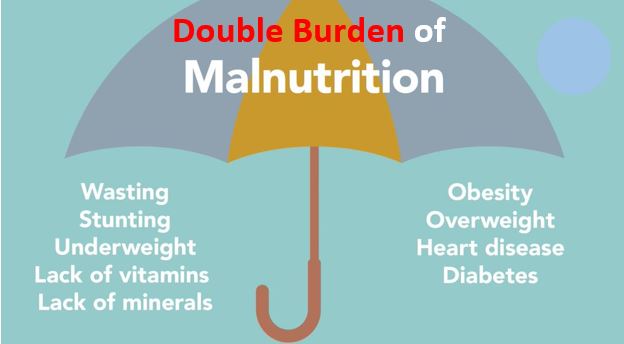
Table of Contents
Double burden of malnutrition:
- Double burden of malnutrition refers to the dual burden of under and over nutrition occurring simultaneously within a population.
- Due to the nutrition transition (changes in the composition of the diet, usually accompanied by changes in physical activity levels) the burden has increased from singular under nutrition burden to double over nutrition burden.
- Historically, under nutrition had prevalent with increased number of infectious diseases but nutrition transition has brought up increases in overweight with obesity
- Recently, even in the low-and-middle income countries, ‘double burden of malnutrition’, consisting of under nutrition among children and over nutrition in adults exist in high rates with rapid increase in economic development, globalization, and urbanization, tremendous changes in lifestyle and changes in diet and physical activity.
- In 2014, more than 1.9 billion adults worldwide, 18 years and older, were overweight while 462 million were underweight (WHO)
- In low and middle-income countries there is a simultaneous rise in childhood overweight and obesity – increasing at a rate 30% faster than in richer nations.
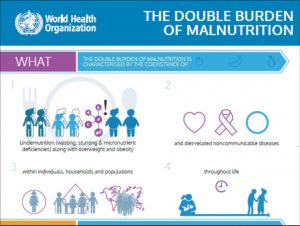
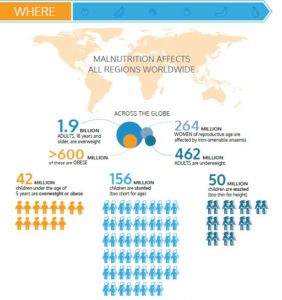
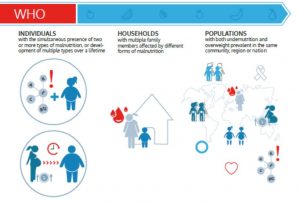
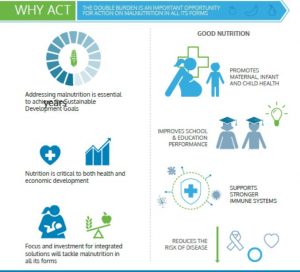
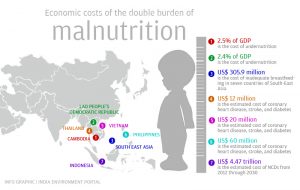
Challenges for addressing double burden of malnutrition:
According to WHO, following are the challenges observed worldwide regarding malnutrition (both underweight and overweight):
Under nutrition:
- About 104 million children worldwide (2010) are underweight
- Under nutrition contributes to about one third of all child deaths
- Stunting (an indicator of chronic under nutrition) hinders the development of 171 million children under age 5 according to 2010 figures
- 13 million children are born with low birth weight or prematurely due to maternal under nutrition and other factors
- Lack of essential vitamins and minerals in the diet affects immunity and healthy development. More than one third of preschool-age children globally are Vitamin A deficient
- Maternal under nutrition, common in many developing countries, leads to poor foetal development and higher risk of pregnancy complications
- Together, maternal and child under nutrition account for more than 10 percent of the global burden of disease
Overweight and obesity:
- About 1.5 billion people are overweight worldwide, of whom 500 million are obese, in 2008 figures
- About 43 million children under age 5 were overweight in 2010
- Growing rates of maternal overweight are leading to higher risks of pregnancy complications, and heavier birth weight and obesity in children
- Worldwide, at least 2.6 million people die each year as a result of being overweight or obese.
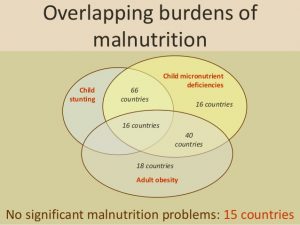
Global approaches for reduction of global burden of malnutrition:
1. Double duty actions:
- Double-duty actions include interventions, programmes and policies that have the potential to simultaneously reduce the risk or burden of both under nutrition (including wasting, stunting and micronutrient deficiency or insufficiency) and overweight, obesity or diet-related NCDs (including type 2 diabetes, cardiovascular disease and some cancers).
- Some examples may include policies to ensure access to optimal maternal and antenatal nutrition and care; the protection, promotion and supporting of breastfeeding.
2. United nations decade of action on nutrition:
It outlines six key areas for policy action. They are:
- Food systems for healthy, sustainable diets:
Actions and food systems to promote and provide healthy, sustainable diets, strengthening local food, enhance the resilience of the food supply in crisis-prone areas with integrated management. - Social protection and nutrition-related education: Implementation of nutrition education and information interventions, social protection based on national dietary guidelines and coherent policies related to food and diets, safety-net programmes, cash and food transfers, school feeding programmes and other forms of social protection for vulnerable populations.
- Aligned health systems providing universal coverage of essential nutrition actions: Health-care, health-systems strengthening and universal health coverage, promotion of universal access to all direct nutrition actions, health programmes.
- Trade and investment for improved nutrition: Identification of opportunities to achieve global food and nutrition targets, improvement in the availability and accessibility of the food supply through trade and investment policies.
- Safe and supportive environments for nutrition at all ages: This action is for addressing the social (school, workplace and city contexts) and environmental (water, sanitation and hygiene) determinants of malnutrition, the promotion, protection and support of optimal breastfeeding practices.
- Strengthen and promote nutrition governance and accountability: Action focuses on the policies, plans and frameworks of Member States’ governance including measures for reviewing, updating and strengthening national strategies, national cross government, intersect oral, multi-stakeholder mechanisms, adopting and adapting international guidelines on healthy diets.
3. Sustainable Development Goals:
- Strategic educational means of implementation:
1 . By 2030, all governments provide health services and nutrition education programmes in all communities; all people have access to caregivers, health professionals and high quality and up-to-date nutritional information.
2. By 2030, all communities have comprehensive and integrated health literacy programmes including maternal, infant and child health.
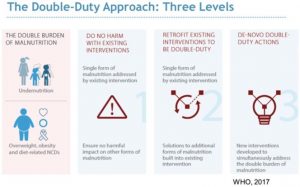
Additionally, other mitigation strategies for prevention of double nutrition are:
| For under nutrition | For over nutrition |
| Use of modern agricultural techniques to increase agricultural production | Increment in primordial prevention methods |
| Proper education to people regarding importance of food | Consumption of carbohydrate less food |
| Enrichment in food | Policies associated with ban on cholesterol high food |
| Food fortification | Nutrition counselling |
| Availability of staple foods at affordable rates |
References and For More Information:
https://data.unicef.org/topic/nutrition/malnutrition/
https://www.nhsinform.scot/illnesses-and-conditions/nutritional/malnutrition
http://www.who.int/news-room/fact-sheets/detail/malnutrition
http://www.who.int/features/qa/malnutrition/en/
https://www.news-medical.net/health/Causes-of-malnutrition.aspx
https://www.nursingtimes.net/malnutrition/5001811.article
http://www.who.int/quantifying_ehimpacts/publications/eb12/en/
https://www.childfund.org/Content/NewsDetail/2147489271/
https://www.slideshare.net/harshrajshinde1/malnutrition-consequences-causes-prevention-and-control
https://www.ncbi.nlm.nih.gov/pmc/articles/PMC3529312/
http://www.fao.org/docrep/009/a0442e/a0442e03.htm
http://www.who.int/nutrition/double-burden-malnutrition/en/
https://www.slideshare.net/LamiaaGamal/malnutrition-47406428
https://sightandlife.org/blog/double-burden-malnutrition/
http://www.ipsnews.net/2014/11/the-double-burden-of-malnutrition/
https://openknowledge.worldbank.org/handle/10986/27417
https://www.slideshare.net/krishnagar90/malnutrition-nutritional-health-problems
http://www.who.int/nutrition/challenges/en/
https://www.medicalnewstoday.com/articles/179316.php
https://richmondvale.org/effects-of-malnutrition/
https://www.ncbi.nlm.nih.gov/pubmed/21617109
https://www.ncbi.nlm.nih.gov/pmc/articles/PMC4313560/
http://www.who.int/nutrition/double-burden-malnutrition/en/
http://www.who.int/publications/guidelines/reproductive_health/en/
http://apps.who.int/iris/bitstream/10665/149018/1/WHO_NMH_NHD_14.2_eng.pdf?ua=1
http://www.who.int/nutrition/challenges/en/
https://www.ncbi.nlm.nih.gov/pmc/articles/PMC4313560/